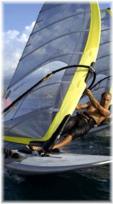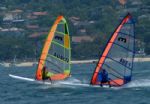Formula Windsurfing Olympic Class Bid
The Bid is made by IBSA to ISAF, supported by IFCA and the PWA, founder members of the IWA.
THE MACRO-ARGUMENTS FOR FORMULA
Windsurfing equipment evolves very quickly : each year sees improvements
in board and sail design. The Mistral One Design has now been in use
since 1993. Sailing on a Mistral One Design has been compared with
skiing on wooden skis – it is not representative of the sport, and is
therefore neither exciting nor relevant. Formula Windsurfing allows
development, and means that windsurfing will never again be locked into
the past ; a free market also ensures the best equipment at the lowest
prices.
Modern equipment is fully capable of planing in less than 7 knots of wind
: meaning that Olympic windsurfing can be exciting and attractive, and
provide positive promotion for the sport.
Formula Windsurfing reflects the contemporary sport : more than 57,000
boards were sold over the last two years, less than 2,000 of these were
the Mistral One Design : these were provided primarily to National
Federations for their Olympic use, they were not recreational sales.
Most importantly, by adopting Formula Windsurfing as the Olympic Class,
windsurfing will finally be united with ISAF : by integrating the
grassroots of the sport into the day to day business of the MNAs, ISAF
will finally represent the sport in essence, as well as statute.
RESPONSE TO THE ISAF EVENTS COMMITTEE CRITERIA
1. Olympic Windsurfing should reflect competition formats on all levels
and around the world.
Funboard racing represents a clear majority of competitive
windsurfers globally, with competition at all levels - Elite, National,
Youth and Women’s.
In 2000, of 44 national windsurfing associations surveyed, 32 were already
running Formula Windsurf competition – unprompted development based on
its simple successful formula. ALL IFCA National Windsurfing
Associations (43 countries) will race Formula Windsurfing rules for 2001
for Course Racing.
Formula Windsurfing has a full program of international standard events
scheduled for 2000-2003 including in 2000 : a World Championship, 4
Continental championships (Europe, North America, South America, Asia),
European Points Series and a Youth and Masters World Championship.
2. Olympic Windsurfing should be modern and attractive for both
the participants and the media.
The image of a planing windsurfing board travelling at high speed
is attractive to the media: the image of a board being ‘pumped’ along at
low speeds is not attractive to the press or media.
The potential appeal of Formula Windsurfing is indicated by the popularity
of the PWA, which attracts crowds of over 20,000 at its biggest events,
enjoys its own 26 part TV series in 45 counties. Funboard is the almost
exclusive focus of the windsurf press : the windsurfing media support
for Formula Windsurfing is practically unanimous.
Courses and Race Formats have been developed (and continue to be
developed) to satisfy the needs of both competitors and media across the
entire wind range and a variety of conditions, providing exciting
competition for participants.
3. The format and equipment should be usable for competition all
around the world.
Formula Windsurfing equipment is currently being raced nationally
in 32 countries in all water from flat and sheltered through to heavy
seas, and in wind speeds from 6 to 40 knots.
4. The equipment should be actively raced by women
The women who windsurf will use whatever equipment is
chosen for 2004. Olympic windsurfing, irrespective of the material used
has always achieved 30% participation by women athletes.
If Formula Windsurfing equipment is selected, women will have
significantly more support from manufacturers and sponsors and the pool
of women who might be interested in Olympic competition will be
dramatically increased.
5. The equipment should be production equipment and commercially
available around the world and if possible from more than one
manufacturer.
By definition, the equipment used for Formula Windsurfing is
production equipment commercially available from more than one
manufacturer.
Five of the major windsurfing brands supporting the Formula Windsurfing
Bid are distributed by ‘Boards and More’, who also distribute Mistral
One Design : other manufacturers augment this, meaning that Formula
Windsurfing equipment has demonstrably better distribution than One
Design.
In ‘98 and ‘99, ISAF's own records show that at least 57,000 new Formula
Windsurfing boards were built and distributed : in the same period, the
same records show that less than 2000 IMCO one designs were built.
Annual Production Board registration fees are more than 5 times the
annual ISAF revenue from IMCO.
6. The format and equipment should be capable of being used in a wind
range from 6 > 35 knots.
During the 1999 and 2000 racing seasons, National Windsurfing
Authorities have constantly been providing feedback on Formula
Windsurfing competition. So far in 2000 over 150 FW windsurf races have
been held in 32 countries. The formats and courses of Formula
Windsurfing more than comply with the 6 – 35 knot wind-speed
requirement.
7. The equipment shall be of high quality, durable and affordable.
Formula Windsurfing equipment is fully "race developed" and
utilises the latest build technology and materials. Rig and hull prices
are similar to that of the "low tech" IMCO one design.
Manufacturers have agreed to support the class of Formula Windsurfing and
a free market environment will ensure that equipment is high quality and
that prices are kept low.
Breakages amongst other brands are generally far lower than for Mistral
One Design.
8. Olympic windsurfing should be capable of being competed in
by people in as wide a physique range as possible.
Placing strict limitations on equipment favours sailors of a
certain size and weight.
The current fleet range for Olympic competitors is 61-74kg for the men and
52-65kg for the women. The current PWA race fleet range in body weight
from 65-115 kg for the men and 50-85kg for the women.
Formula Windsurfing, allowing sailors to choose their own equipment –
within limitations – enables a wider physical range of sailors to share
a real opportunity of winning.
9. The format and equipment should reduce the need to pump,
whilst at the same time being at least as physically demanding as it is
now.
Formula Windsurfing relies upon physical effort to sail the
equipment but does not rely upon physical effort to propel the board
kinetically. No Formula Windsurfing race has ever relied upon pumping as
the principal means of propulsion. In normal conditions (7 knots+) even
95 kilo sailors can plane.
Consequently Formula Windsurfing has no need for rules about the maximum
number of races per day as racers are not exhausted and dehydrated from
pumping round the course.
The Lightwind Elimination format guarantees that major events produce
valid Champions!
10. Equal opportunity for all nations to compete at the highest
level.
Should Formula Windsurfing equipment be selected for use at the 2004
Games, all boards will be provided free of charge by the manufacturers.
Various packages are already on offer and these will increase if Formula
Windsurfing is selected.
Improved distribution, greater existing availability, a free market, a
greater ‘gene’ pool for competitors and far broader weight tolerances
all provide nations with greater opportunity to compete.
11. Competitors in Olympic windsurfing on all levels should not
be exposed to excessive health risks.
Formula Windsurfing does not rely on pumping and has no more health risks
than any other style of sailing that has no reliance on pumping for
propulsion.
12. The restrictions on the equipment: 1 board, 3 sails and
other equipment restrictions to limit costs.
This is the definition of the Class.
Formula Windsurfing Youth competitors will be restricted to one board, two
sails and one fin from next year.
13. Attract the best and best known sailors
The best known sailors compete within the Professional
Windsurfers Association (PWA), and the PWA has been strongly supportive
of the campaign for Formula Windsurfing.
Formula Windsurfing provides an inclusive international class that allows
the current Olympic, IFCA, IBSA and PWA sailors to compete on equal
terms.
At this years Boot in Dusseldorf, Mistral’s own team riders, on the stand
for a press and "Autograph session " were asked by an ISAF delegate :
What is the future for Olympic windsurfing? The response was : "None
with the current equipment."
14. Part of the programme should lead the sport and another
part should reflect the sport.
Formula Windsurfing allows the PWA sailors, the stars of the
sport, to compete in the Olympics, providing an aspirational lead for
the sport.
It reflects the style of racing and equipment used by the vast majority of
competitive and recreational windsurfers world-wide, encouraging
development from both ends of the sports continuum.
Most importantly, Formula Windsurfing will lead the sport by allowing
investment by National Federations into a majority, rather than a
minority aspect of the sport.
15. In addition and finally, unifying the sport of windsurfing
Formula Windsurfing is uniting the sport of windsurfing : it has
already united the IBSA, IFCA and the PWA, all of the magazines and all
of the industry. The overwhelming majority of windsurfers use Funboards
and support Formula.
These classes of windsurfing are forming the International Windsurfers
Association : the IWA will produce a single calendar, a single rulebook
and a single front for windsurfing.
The final hurdle is to unite Windsurfing and ISAF and only Formula
Windsurfing can do this - by integrating the grassroots of the sport
into the day to day business of the MNAs, ISAF will finally represent
the sport in essence, as well as statute.




